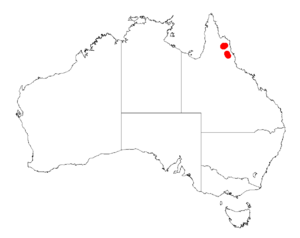Acacia johannis facts for kids
Quick facts for kids Acacia johannis |
|
|---|---|
| Scientific classification | |
| Genus: |
Acacia
|
| Species: |
johannis
|
 |
|
| Occurrence data from AVH | |
Acacia johannis is a type of shrub that belongs to the Acacia family. It's a special plant because it's only found in a small part of northeastern Australia. This means it's endemic to that area, like a plant that only lives in one specific place on Earth!
What Acacia johannis Looks Like
This shrub usually grows to be about 2 meters (around 6.5 feet) tall. Its branches are reddish-brown and smooth, with small bumps on them. Like most Acacia plants, it has special leaf-like parts called phyllodes instead of true leaves.
These phyllodes are always green and smooth. They are shaped like a sickle, which means they are curved. Each phyllode is about 14 to 18 centimeters (5.5 to 7 inches) long and 5 to 14 millimeters (0.2 to 0.55 inches) wide. They have three or four clear lines running lengthwise, and some fainter, smaller lines too.
The plant blooms in February and April. It produces simple flower clusters, either alone or in pairs. Each flower head has about 50 lemon-yellow flowers.
Naming and Classification
A botanist named Leslie Pedley first officially described and named this plant in 1999. He wrote about it in a scientific journal called Austrobaileya.
Later, in 2003, Pedley changed its scientific group, calling it Racosperma johannis. But then, in 2006, it was moved back to the Acacia group. This shows how scientists sometimes change their minds as they learn more about plants!
Where Acacia johannis Lives
Acacia johannis is only found in a small area of far north Queensland, Australia. It grows around a place called Mount Mulligan. In this area, it often forms thick groups of plants.
You can usually find it growing on and among rocky areas and outcrops. It prefers thin, rocky soil that is made from sandstone.

